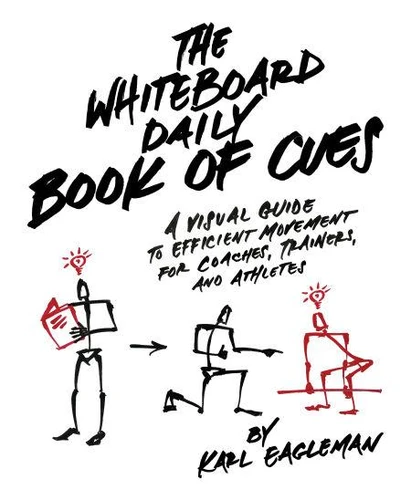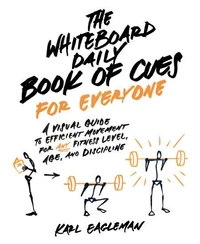The Whiteboard Daily Book Of Cues. A Visual Guide to Efficient Movement for Coaches, Trainers, and Athletes
Par :Formats :
Disponible dans votre compte client Decitre ou Furet du Nord dès validation de votre commande. Le format ePub protégé est :
- Compatible avec une lecture sur My Vivlio (smartphone, tablette, ordinateur)
- Compatible avec une lecture sur liseuses Vivlio
- Pour les liseuses autres que Vivlio, vous devez utiliser le logiciel Adobe Digital Edition. Non compatible avec la lecture sur les liseuses Kindle, Remarkable et Sony
- Non compatible avec un achat hors France métropolitaine
 , qui est-ce ?
, qui est-ce ?Notre partenaire de plateforme de lecture numérique où vous retrouverez l'ensemble de vos ebooks gratuitement
Pour en savoir plus sur nos ebooks, consultez notre aide en ligne ici
- Nombre de pages288
- FormatePub
- ISBN978-1-62860-146-6
- EAN9781628601466
- Date de parution26/07/2022
- Protection num.Adobe DRM
- Taille70 Mo
- Infos supplémentairesepub
- ÉditeurVictory Belt Publishing
Résumé
There is no such thing as a "golden cue" that works for everyone 100% of the time. Therefore, the more cues a coach has in their toolbox, the more likely they will be able to effectively communicate with their athletes. Coaches use cues-short, easy-to-remember phrases-to help athletes perform movements correctly as well as to convey useful sports psychology perspectives. Athletes commonly hear movement cues like "Crush the Can" and "Grip the Ground" along with motivational cues like "Consistency is King." A passionate coach, lifelong athlete, and advanced degree holder in kinesiology, Karl Eagleman, creator of the popular Whiteboard Daily Instagram, has put together a valuable resource for coaches, athletes, and anyone who wants to improve their own movement. The Whiteboard Daily Book of Cues contains a comprehensive collection of illustrations drawn on a whiteboard-a medium that virtually all coaches are familiar with.
It boasts the largest list of cues ever compiled, covering Olympic weightlifting, powerlifting, gymnastics, kettlebell exercises, and monostructural movements (running, rowing, jumping rope, etc.). Each illustration is hand drawn in a simple, stylized way to make the cues easy to retain and to utilize during training. No two athletes are the same; we all learn in our own unique ways. By providing hundreds of cues, this book will help coaches and athletes learn a new way to understand movement for themselves and/or to communicate safe, effective movement to others.
It boasts the largest list of cues ever compiled, covering Olympic weightlifting, powerlifting, gymnastics, kettlebell exercises, and monostructural movements (running, rowing, jumping rope, etc.). Each illustration is hand drawn in a simple, stylized way to make the cues easy to retain and to utilize during training. No two athletes are the same; we all learn in our own unique ways. By providing hundreds of cues, this book will help coaches and athletes learn a new way to understand movement for themselves and/or to communicate safe, effective movement to others.
There is no such thing as a "golden cue" that works for everyone 100% of the time. Therefore, the more cues a coach has in their toolbox, the more likely they will be able to effectively communicate with their athletes. Coaches use cues-short, easy-to-remember phrases-to help athletes perform movements correctly as well as to convey useful sports psychology perspectives. Athletes commonly hear movement cues like "Crush the Can" and "Grip the Ground" along with motivational cues like "Consistency is King." A passionate coach, lifelong athlete, and advanced degree holder in kinesiology, Karl Eagleman, creator of the popular Whiteboard Daily Instagram, has put together a valuable resource for coaches, athletes, and anyone who wants to improve their own movement. The Whiteboard Daily Book of Cues contains a comprehensive collection of illustrations drawn on a whiteboard-a medium that virtually all coaches are familiar with.
It boasts the largest list of cues ever compiled, covering Olympic weightlifting, powerlifting, gymnastics, kettlebell exercises, and monostructural movements (running, rowing, jumping rope, etc.). Each illustration is hand drawn in a simple, stylized way to make the cues easy to retain and to utilize during training. No two athletes are the same; we all learn in our own unique ways. By providing hundreds of cues, this book will help coaches and athletes learn a new way to understand movement for themselves and/or to communicate safe, effective movement to others.
It boasts the largest list of cues ever compiled, covering Olympic weightlifting, powerlifting, gymnastics, kettlebell exercises, and monostructural movements (running, rowing, jumping rope, etc.). Each illustration is hand drawn in a simple, stylized way to make the cues easy to retain and to utilize during training. No two athletes are the same; we all learn in our own unique ways. By providing hundreds of cues, this book will help coaches and athletes learn a new way to understand movement for themselves and/or to communicate safe, effective movement to others.




